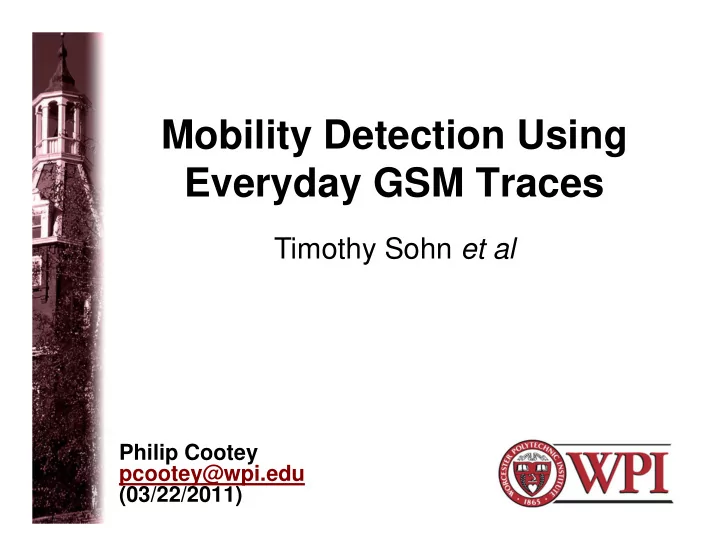

Mobility Detection Using Everyday GSM Traces Timothy Sohn et al Philip Cootey pcootey@wpi.edu (03/22/2011)
Mobility Detection • High level activity discerned from course Grained GSM Data provides immediate opportunities to applications that do not require high definition of mobility. • In a one month study with three participants the author was able to predict within an 85% accuracy in activity categories and accurate step counts . 2 Worcester Polytechnic Institute
Primary Premise • Detail not required for many applications 3 Worcester Polytechnic Institute
Computer-Supported Coordinated Care • Authors identify immediate applications to the CSCC space where 50% of Americans aged 65 to 74 and 30% aged 75 to 94 have mobile phones. 4 Worcester Polytechnic Institute
Step Counts • Authors Identify immediate need in healthcare for ubiquitous step counting capabilities in their fight against heart disease, diabetes and obesity. 5 Worcester Polytechnic Institute
Common Usages not Cost effective Course and Fine Grained • Smart Spaces • RFID tags • Lester belt-worn sensor clusters 6 Worcester Polytechnic Institute
GPS vs GSM • 5% Coverage in a typical persons Day to Day life • Paper demonstrates certain high grained activities can be identified on GSM alone 7 Worcester Polytechnic Institute
Proved • Statistical Classification and Boosting Techniques detects – Walking – Driving – Remaining in Place • Without overhead of additional sensors 8 Worcester Polytechnic Institute
Step Counter • Using their method they predicated comparative step counts to commercial step counters. 9 Worcester Polytechnic Institute
Their System • Application on Audiovox SMT 5600 – Measure and Record Surrounding GSM radio environment (every second) – Each reading accounts for seven towers • Signal Strength Values • Cell IDs • Channel Numbers – 15 additional reads • Signal Strength • Channel Numbers 10 Worcester Polytechnic Institute
Inferring User Mobility Modes • “Extract a set of features that indicate proportional levels of movement” • Basically, If the set of towers and signal strengths change, then the phone is moving. 11 Worcester Polytechnic Institute
Euclidean Distance Values • They can differentiate between walking, driving and being still • Slow Driving and Fast Walking may look the same • Focus is on the magnitude of the change 12 Worcester Polytechnic Institute
13 Worcester Polytechnic Institute
7 Feature Classification System 14 Worcester Polytechnic Institute
Two Stage Classification System • Stage One – Moving of not moving • Stage Two – If not moving then walking or driving 15 Worcester Polytechnic Institute
Trained Classification System • Boosted Logistics Regression Technique • All aglo were provided by the weka machine learning toolkit • Steps: total the number of waling periods and multiply by an appropriate step rate 16 Worcester Polytechnic Institute
Evaluation : Ground Truth • 3 people 1 month • Audiovox SMT 6500 App to record doing what and when correlated with written log • Calibrated Pedometer: Omron Healthcare HJ-112 (between the three 50 days of step counts) 17 Worcester Polytechnic Institute
Inferring Mobility Modes • Infer One of Three States • Issues with training for non-moving state as non-moving state includes movement (TV room to kitchen) • Compromise data dropped that wasn’t between 2 and 5 am 18 Worcester Polytechnic Institute
19 Overall 85% accuracy Worcester Polytechnic Institute
Inferring Steps • No need to exclude data, pedometer always counting no matter the activity and location, same with GSM. • GSM Step counter not calibrated • Drove data through linear regression with a 5 forked cross validation on their data set to get formula – Daily step count = 25* (minutes of walking) 20 Worcester Polytechnic Institute
Steps not so bad • 1500 to 12000 steps with average of 5000 from GSM • Differed from Omron – 1400 steps per day • Ran second experiment with similar results against different models of pedometers. 21 Worcester Polytechnic Institute
CSCC Applications • Seeks to improve the qualify of care while reducing the burden on the members in the care network of the individual • This mobility detection method can use GSM driven activity inference to convey care and wellness information 22 Worcester Polytechnic Institute
Social Media Applications • http://socialight.com • http://www.textamerica.com 23 Worcester Polytechnic Institute
Related Work • SHARP – Fine grained activity sensing with RFID • Wearable Sensors (think cyborg) • Reality Mining: Bluetooth capable phone for inferring relationships 24 Worcester Polytechnic Institute
Conclusions • Demonstrated Feasibility • Demonstrated value to such applications as CSCC and social- mobile applications • Evaluated Effectiveness • Demonstrated recognition of mobility patterns • No special Devices required 25 Worcester Polytechnic Institute
Recommend
More recommend